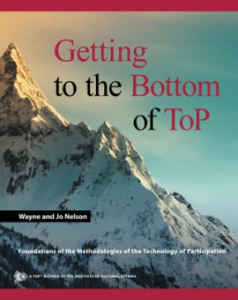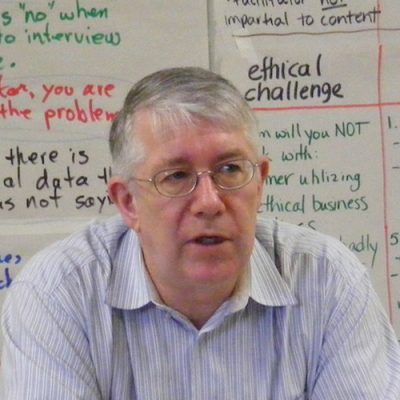Are you asking what is the secret that makes ToP methods really work? Or do you want to understand the steps of a particular ToP method?
Getting to the Bottom of ToP is the result of a decade of work to document 50 years of development of the foundations of ToP methodology. Wayne Nelson spent years researching and interviewing those involved in creating the methods, and making the underlying philosophy accessible. Jo Nelson completed his work after his death.

The book, for practitioners and academics alike, is available from iUniverse.ca and also from Amazon.com and other online booksellers. All royalties go to ICA Canada.
Interviews about the book:
https://www.icacan.org/2018/01/17/getting-to-the-bottom-of-top-interview-with-jo-nelson/
https://youtu.be/Hf-UdTGQrKQ
Reviews:
A deep bow to Jo and Wayne for providing a profound and helpful exploration of the phenomenology of practice of ToP. I have longed for decades for this book. In this breakthrough work the Nelsons expose the philosophical foundations of the ICA’s ToP methods in ways that scholars and facilitators alike will find useful. By tracing ToP’s ancestry to the existentialist’s insights of Kierkegaard and Sartre, and the phenomenological methods of Husserl and Heidegger, this book not only provides conceptual clarity but releases a deep wellspring of motivation and skillfulness for practitioners of ToP. I will definitely use this book in teaching my NYU Wagner grad courses on innovative leadership.
Robertson Work, author of A Compassionate Civilization, NYU Wagner professor, and UN consultant
This book, initiated by Wayne Nelson and completed after his death by his wife Jo, his lifetime partner both in life and in work, offers clear and fulsome answers to the origins of ICA and shares educative insights on ToP, its continually evolving compendium of methods of engaging social participation. The authors trace the work of ICA through its years of cutting edge growth in social development under the powerful influence of thought-leaders from the intersecting and complex fields of phenomenology, existentialism and theology. However, one does not need to be a philosopher or theologian to approach the text – the authors make the concepts accessible by using language that is foundational to human experience. They search ‘for the core concepts of what it means to be ‘human’ and they describe ToP methods as arising from “the most basic set of assumptions about life that [humans] use as foundations for our values, mental models and actions.” It is on the solid ground of descriptive universal human experience that the book stands.
This book is clearly explanatory in its clarification of the essential phenomenological philosophy and history of ICA and is also extraordinarily generous in the presentation of the facilitation methods of ToP. It is structured in four sections – Theory and Background of ToP, Core Applications of ToP Methods, Facilitation Design, and Study Models. It encompasses thirteen chapters that offer serious intellectual analysis of the method’s philosophical foundations but the content comes alive with real stories and examples of facilitation challenges and successes. It provides frameworks, methods, resources and references that are integral to the promulgation of its programs. Having said that, while the book will be extremely illuminating to an experienced facilitator, it is not a training manual. It is also not a book of tips and strategies that can be used to manipulate a group to move along to decision. ToP methods must be lived in order to be learned.
Getting to the Bottom of ToP, like the ToP methods themselves, primarily represents a way of being in relationship with other humans, as “free beings acting in profound responsibility”. It implicitly challenges its readers to achieve elevated moral ground in all our human interactions, not just on a personal level, but in the building of social capital, the pursuit of socially just processes, and the encouragement of a kinder and more humane world. These authors hand us the tools to get started.
Maureen Dunne, PhD, Retired Professor, Memorial University, St. John’s, Newfoundland
Getting to the Bottom of ToP works at two levels: as a guide to a range of processes that elicit participation in a way that brings insights to the surface and ensures the full range of participants are invested in collaborating to bring the resulting plans or actions to fruition; and as a theoretical basis for those processes drawn from the philosophical field of phenomenology—an answer to any of us who have pondered what principles or theory about personal and group change underlie those processes.
Peter J. Taylor, Critical & Creative Thinking Graduate Program, UMass Boston
Robertson Work, author of A Compassionate Civilization, NYU Wagner professor, and UN consultant
This book, initiated by Wayne Nelson and completed after his death by his wife Jo, his lifetime partner both in life and in work, offers clear and fulsome answers to the origins of ICA and shares educative insights on ToP, its continually evolving compendium of methods of engaging social participation. The authors trace the work of ICA through its years of cutting edge growth in social development under the powerful influence of thought-leaders from the intersecting and complex fields of phenomenology, existentialism and theology. However, one does not need to be a philosopher or theologian to approach the text – the authors make the concepts accessible by using language that is foundational to human experience. They search ‘for the core concepts of what it means to be ‘human’ and they describe ToP methods as arising from “the most basic set of assumptions about life that [humans] use as foundations for our values, mental models and actions.” It is on the solid ground of descriptive universal human experience that the book stands.
This book is clearly explanatory in its clarification of the essential phenomenological philosophy and history of ICA and is also extraordinarily generous in the presentation of the facilitation methods of ToP. It is structured in four sections – Theory and Background of ToP, Core Applications of ToP Methods, Facilitation Design, and Study Models. It encompasses thirteen chapters that offer serious intellectual analysis of the method’s philosophical foundations but the content comes alive with real stories and examples of facilitation challenges and successes. It provides frameworks, methods, resources and references that are integral to the promulgation of its programs. Having said that, while the book will be extremely illuminating to an experienced facilitator, it is not a training manual. It is also not a book of tips and strategies that can be used to manipulate a group to move along to decision. ToP methods must be lived in order to be learned.
Getting to the Bottom of ToP, like the ToP methods themselves, primarily represents a way of being in relationship with other humans, as “free beings acting in profound responsibility”. It implicitly challenges its readers to achieve elevated moral ground in all our human interactions, not just on a personal level, but in the building of social capital, the pursuit of socially just processes, and the encouragement of a kinder and more humane world. These authors hand us the tools to get started.
Maureen Dunne, PhD, Retired Professor, Memorial University, St. John’s, Newfoundland
Getting to the Bottom of ToP works at two levels: as a guide to a range of processes that elicit participation in a way that brings insights to the surface and ensures the full range of participants are invested in collaborating to bring the resulting plans or actions to fruition; and as a theoretical basis for those processes drawn from the philosophical field of phenomenology—an answer to any of us who have pondered what principles or theory about personal and group change underlie those processes.
Peter J. Taylor, Critical & Creative Thinking Graduate Program, UMass Boston



